古街の衰退をくい止め、美しいまちを後世に残すために、20年ほど前に立ちあがった宇多津町の町家再生プロジェクト。
これから先の100年も地域の営みが続いていくようにと動き出したプロジェクトは、古民家の改修や新しい事業の実践を行ってきました。
今回はそのプロデューサーとしてこの取り組みを見守ってきた東洋文化研究家アレックス・カー氏に、宇多津の街の魅力についてインタビューしました。
The Utazu Town Machiya Regeneration Project, which was launched about 20 years ago, aims to stop the decline of Co-machi and preserve its beauty for future generations.
The project, started with the aim of ensuring the continuation of the community’s activities for the next one hundred years, has involved the renovation of traditional houses and the implementation of new initiatives.
This time, we interviewed Alex Kerr, a researcher of Eastern culture who has been seeing the project as its producer, about the charm of the town of Utazu.
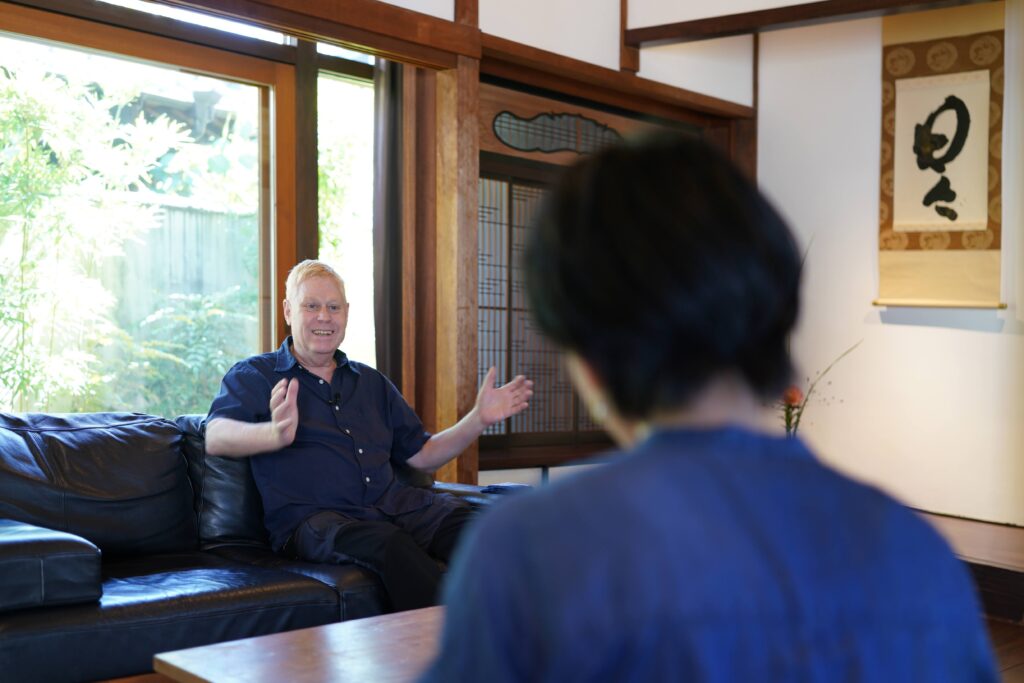
― “街”としての宇多津の魅力を教えてください。
山の麓に人が住み、そこより少し高い場所に寺社が立ち並ぶ。かつての日本ではそんな寺町の風景をあちこちで見ることができました。しかし、時の流れとともに開発で消滅していった場所も多く、今となっては珍しい光景となっています。
そういう意味では、宇多津の街並みは奇跡みたいなもの。風情が息づき、人々の生活するエリアを寺社が囲み、密接しながら共存しているのは、四国どころか全国でも珍しいのではないでしょうか。
― Please tell us about the charm of Utazu as a town.
People live at the foot of the mountain, with temples and shrines lined up at slightly higher elevations. In the past, such scenes of temple towns could be seen all over Japan. However, with the passage of time and development, many of these places have disappeared, and now they have become a rare sight.
In that sense, the streets of Utazu are like a miracle. The atmosphere still lingers, and the temples and shrines surround areas where people live, coexisting closely. This is rare not only in Shikoku but throughout Japan.
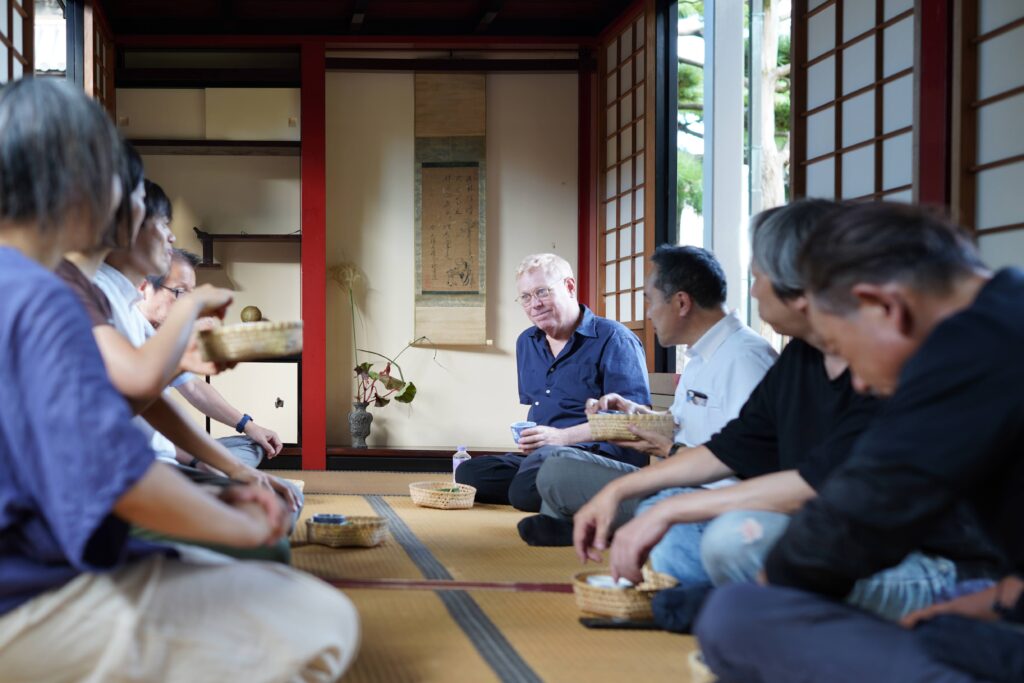
― 自然や環境など、宇多津の地域資源についてはどう思いますか?
私が初めて宇多津を訪れたのは約50年ほど前。まだ瀬戸大橋が通っていない頃でした。その頃から比べると街の様子は年々変化していますが、香川県全体がとてもリッチな土地だという思いに変わりはありません。特に宇多津にはすぐそばに海があり、そして山があり、歴史的に見ても海運や塩田、農業などが発展した豊かな場所で、多様性にも恵まれた素晴らしい環境だと思います。
また、田んぼの脇に四季折々に小さな草花が咲いている光景が、まだたくさん残っているのも宇多津の魅力。日本で花といえば桜。もちろん桜が咲くシーズンはとても美しいですが、私が最も好きなものは道端に咲く季節の草花です。ですからそういった風景を見るとホッとします。ナチュラルが一番素敵。今しか咲かない草花を摘んで、お気に入りの花器に投げ入れて飾るのも風情があって大好きですね。
―What do you think about Utazu’s local resources, such as nature and the environment?
The first time I visited Utazu was about 50 years ago. It was before the Seto Ohashi Bridge was built. Compared to those days, the town has changed year by year, but my belief that the entire Kagawa is a rich land has never changed. Especially in Utazu, the sea is right nearby, and there are also mountains. Historically, it has been a prosperous place with the development of maritime trade, salt production, and agriculture. It is a wonderful environment blessed with diversity.
Additionally, the sight of small wildflowers blooming by the rice fields throughout the seasons is another charm of Utazu, with many such scenes remaining. When it comes to flowers in Japan, cherry blossoms are the most iconic. Of course, the cherry blossom season is incredibly beautiful, but what I love most are the seasonal wildflowers that bloom along the roadsides. So, when I see such landscapes, it brings me a sense of peace. Natural beauty is truly the most wonderful. I also love picking flowers that only bloom for this season and placing them in my favorite vase. It has such a charming and nostalgic feel to it.
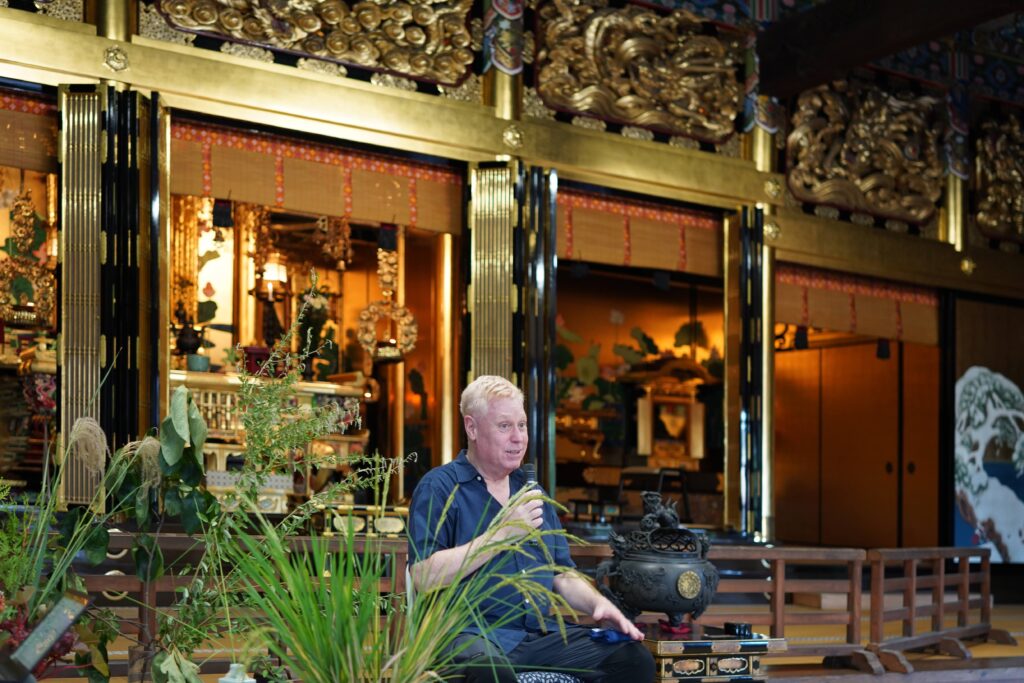
― 歴史や文化的な魅力としてはいかがでしょうか?
日本にはさまざまな宗教が共存し、たとえば仏教一つをとってもたくさんの宗派が存在しています。日本人にとっては普通のことかもしれませんが、実は世界的に見るとこれも珍しいことだと思います。宇多津の街にも神社や寺が点在しています。そしてその近くに家々があり、暮らしが息づいている風景はこれからも残していくべきものだと思っています。
私は父が海軍の弁護士をしていた関係で、幼い頃は横浜に住んでいました。その頃から寺町に興味があり、休みになれば川崎大師や日光へ足を運んだものです。四国との出会いは大学生の時。金刀比羅宮を訪れた時には、横浜で暮らしていた頃にお手伝いのツルさんがよく口ずさんでいた「こんぴらふねふね」はこの地の歌だったと知り、感激したものです。その後、香川でできた友だちに徳島の祖谷を教えてもらったことから、古民家への関心が一気に高まったのですが、宇多津の街にも同じような古くからの風情や郷愁を感じています。これからもずっと残していきたい風景ですね。
― How about the historical and cultural charm of Utazu?
In Japan, various religions coexist, and even within Buddhism, there are many different sects. For Japanese people, this may be a common occurrence, but from a global perspective, it is quite rare. There are shrines and temples scattered throughout the town of Utazu. And I believe the landscape, with homes close to these shrines and temples, where life continues to thrive, is something that should be preserved for the future.
I grew up in Yokohama because my father worked as a Navy lawyer. I have been interested in temple towns since then, and on my days off, I would visit places like Kawasaki Daishi and Nikko. My encounter with Shikoku was when I was a university student. When I visited Konpira Shrine, I was deeply moved to learn that the song “Konpira fune fune,” which the helper Tsuru-san often hummed when I lived in Yokohama, was a song from this region. Later, when a friend I made in Kagawa introduced me to the Iya Valley in Tokushima, my interest in old houses grew significantly. Similarly, I feel a sense of nostalgia and timeless charm in the streets of Utazu as well. It is a landscape that I hope will be preserved for generations to come.
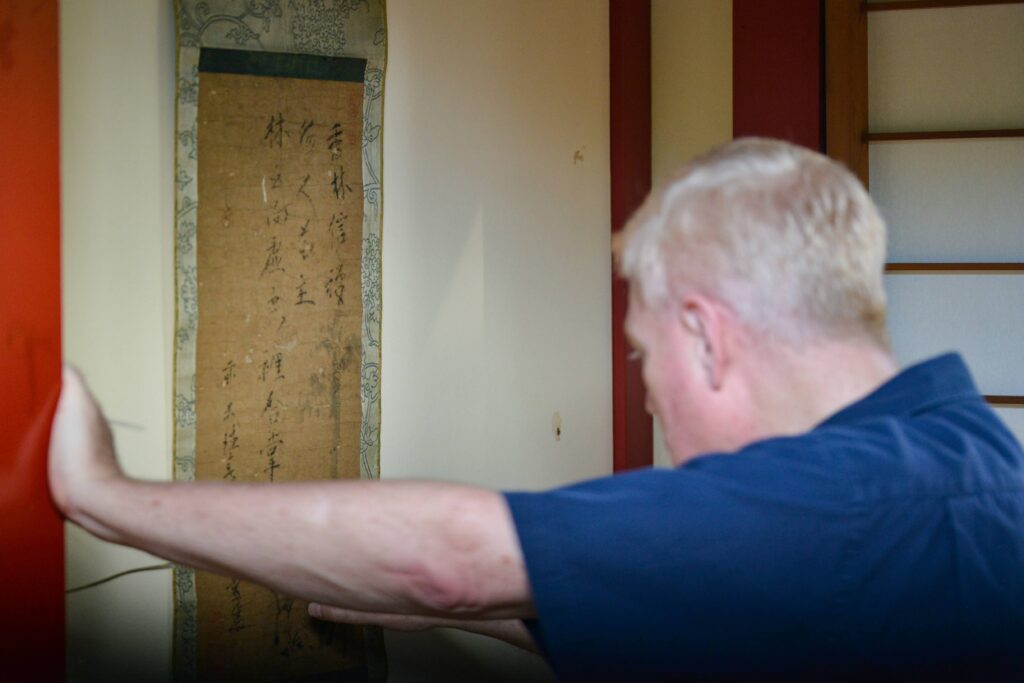
― 宇多津の魅力がもっと広がるために、どういった工夫が必要だと思いますか?
いくつか課題はありますが、まずは空き家の解消ではないでしょうか。街の活性化を進めるためには町家を改装して商業施設や宿泊施設にしたり、移住してきた方が住めるようにしたりという施策を進める必要があると思っています。空き家の活用が進めば自然と注目され、人が集まりにぎわいが出てくるでしょう。
私は宇多津の町家再生プロジェクトの一環で、「背山」と「臨水」という2棟の町家の改築に関わりました。臨水は江戸時代の重厚な趣きを残し、背山は少し西洋のエッセンスが入った大正時代のハイカラな雰囲気があります。改築の際にはそれぞれの建物が持つ本来のイメージを大切にしながら、快適に過ごせるように機能性も備えました。何物にも代えがたい部分は残し、未来に残すために変える部分は変える。長く残すために必要なことは家も街も同じで、新旧のバランスを大切にしていくということだと思っています。
― What do you think is needed for the charm of Utazu to spread even further?
There are several challenges, but first, I believe addressing the issue of vacant houses is essential. To promote the revitalization of the town, we need to renovate townhouses and turn them into commercial spaces or accommodations, as well as make them available for people who want to move here. If the vacant houses are utilized, attention will naturally follow, and it will bring people together, creating a lively atmosphere.
As part of the Utazu Town Machiya Regeneration Project, I was involved in the renovation of two townhouses, “Sezan” and “Rinsui.” Rinsui retains the heavy, dignified charm of the Edo period, while Sezan has a more Western-influenced, stylish Taisho-era vibe. During the renovation, we made sure to preserve the original character of each building while ensuring they were comfortable and functional. What was irreplaceable was preserved, and what needed to be changed to ensure their future was thoughtfully altered. The essential principle for both houses and the town is the same thing: keeping a balance between the old and the new, to ensure longevity and continuity.
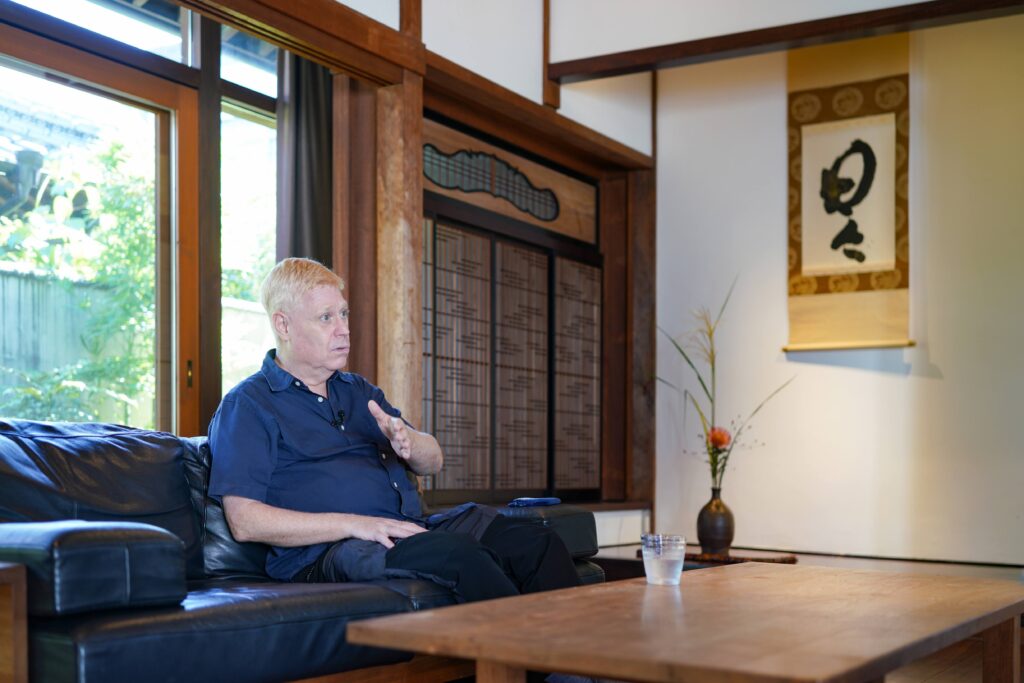
アレックス・カー Alex Kerr 東洋文化研究家
1952年アメリカ生まれ。1964年に初来日。エール、オックスフォード両大学で日本学と中国学を専攻。1977年から京都府亀岡市に在住し、篪庵有限会社設立、執筆、講演、コンサルティング等を開始。2005年に徳島県三好市祖谷でNPO法人篪庵トラストを共同で設立。2014年『ニッポン景観論』(集英社)、2019年『観光亡国論』(中央公論新社)を共著で執筆。現在は、執筆、講演を中心に古民家の利活用プロデュース等の活動を行っている。
Alex Kerr – Resercher of Eastern Culture
Born in 1952 in the United States. Alex Kerr first visited Japan in 1964. He majored in Japanese Studies and Chinese Studies at both Yale and Oxford universities. Since 1977, he has been living in Kameoka City, Kyoto Prefecture, where he established Chiiori Co., Ltd. and began writing, lecturing, and consulting. In 2005, he co-founded the NPO Chiiori Trust in Iya, Miyoshi City, Tokushima Prefecture. In 2014, he co-authored Nippon Keikan Ron (Theory of Japanese Landscape, Shueisha), and in 2019, Kanko Bokokuron (Destroying the Nation with Tourism, Chuo Koron Shinsha). Currently, he focuses on writing and lecturing while also engaging in the revitalization and repurposing of traditional Japanese houses.